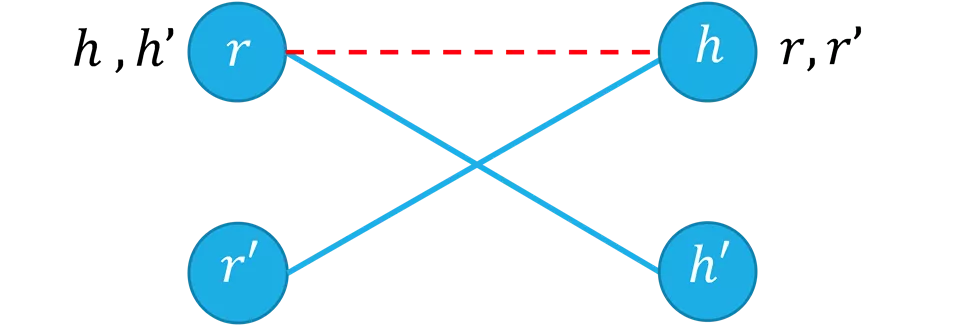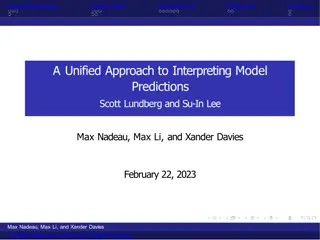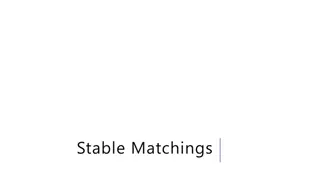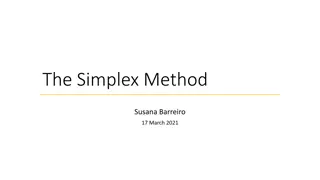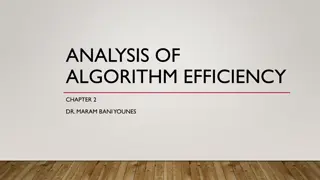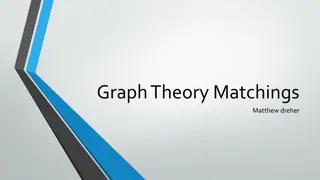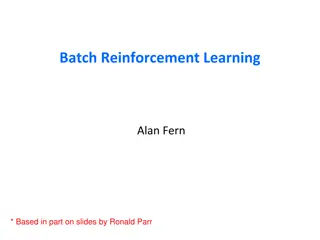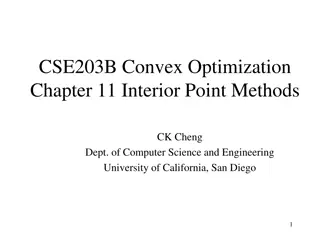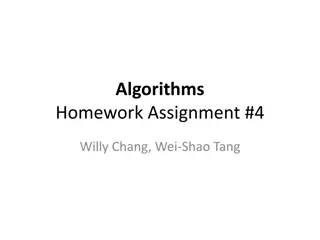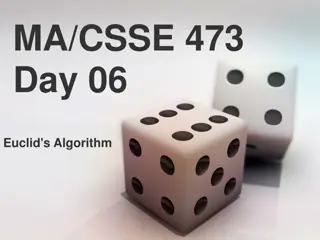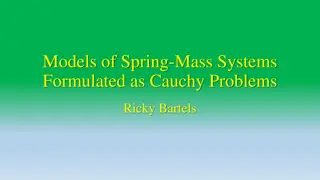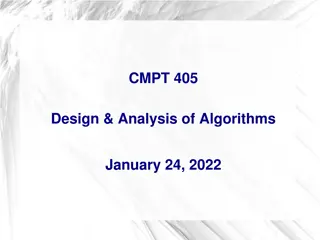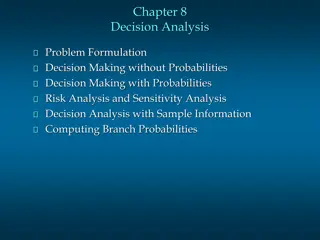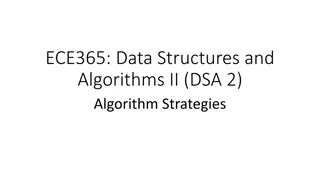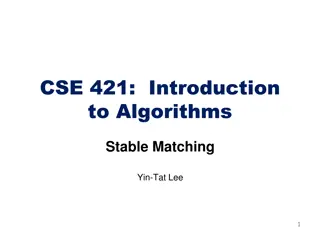Stable Matchings: Problem, Formulation, Gale-Shapley Algorithm
Concept of stable matchings in the context of the Stable Matching Problem. Discussing the formulation of perfect matching and stability criteria. Introducing the Gale-Shapley Algorithm for finding stable matchings efficiently.
Download Presentation

Please find below an Image/Link to download the presentation.
The content on the website is provided AS IS for your information and personal use only. It may not be sold, licensed, or shared on other websites without obtaining consent from the author.If you encounter any issues during the download, it is possible that the publisher has removed the file from their server.
You are allowed to download the files provided on this website for personal or commercial use, subject to the condition that they are used lawfully. All files are the property of their respective owners.
The content on the website is provided AS IS for your information and personal use only. It may not be sold, licensed, or shared on other websites without obtaining consent from the author.
E N D
Presentation Transcript
Stable Matchings CSE 417 21AU Lecture 2
Stable Matching Problem Given two sets R = ?1, ,??,? = { 1, , ?} each agent ranks every every agent in the other set. Goal: Match each agent to exactly one their preferences. How do we respect preferences ? Avoid blocking pairs: unmatched pairs (?, ) where ? prefers to their match, and prefers ? to its match. ? , exactly one agent in the other set, respecting ?,? ?
Stable Matching, More Formally Perfect matching: Each rider is paired with exactly one horse. Each horse is paired with exactly one rider. Stability: no ability to exchange an unmatched pair ?- is blocking if they both prefer each other to current matches. Stable matching: perfect matching with no blocking pairs. Stable Matching Problem Given: the preference lists of ? riders and ? horses. Find: a stable matching.
Questions Does a stable matching always exist? Can we find a stable matching efficiently? We ll answer both of those questions in the next few lectures. Let s start with the second one.
Idea for an Algorithm Key idea Unmatched riders propose to the highest horse on their preference list that they have not already proposed to. Send in a rider to walk up to their favorite horse. Everyone in front of a different horse? Done! If more than one rider is at the same horse, let the horse decide its favorite. Rejected riders go back outside. Repeat until you have a perfect matching.
Gale-Shapley Algorithm Initially all ? in ? and in ? are free While there is a free ? Let be highest on ? s list that ? has not proposed to if is free, then match (?, ) else // is not free suppose (? , ) are matched if prefers ? to r unmatch (? , ) match (?, )
Algorithm Example ?1 1 ?2 ,?3,?1 1 , 2, 3 ?2 2 1 , 3, 2 ?3 ,?1,?2 3 1 , 2, 3 ?3 ?3 ,?1,?2 Proposals: ?1,?2,?1,?3,?3,?1
Does this algorithm work? Want to show two things: 1. The code produces the right output (i.e., you get a stable matching) 2. The code runs in a reasonable amount of time. We ll start with question 2, but we need a detour first
How do we convince someone of a fact about our algorithm? In 373 we usually used tests to convince ourselves our algorithm worked. But that s only helpful if we actually write the code. You ll write code in this class, but you ll do at least as much writing of algorithms in pseudocode. There s no auto-runnable tests for pseudocode. Besides tests don t test everything. What we want is to convince another person if you implemented this algorithm, it would pass the tests you write. Even if they make slightly different decisions than you would
Different Decisions? Our justification needs to work regardless of what data structure keeps track of free ? s. Initially all ? in ? and in ? are free While there is a free ? Let be highest on ? s list that ? has not proposed to if is free, then match (?, ) else // is not free suppose (? , ) are matched if prefers ? to r unmatch (? , ) match (?, ) Our justification needs to work no matter what preference lists the ? and have. That would be a lot of tests. Our justification needs to work for any language or design choice (are ?, objects?) For this class, our hope is that the algorithm ideas will be useful in other contexts (with doctors and hospitals or TAs and courses not just horses and riders). The more general we keep our analysis, the more likely it can be applied to new contexts!
How do we show facts about our algorithms? Usually we ll formulate our facts as implications: An implication is a promise a statement of the form if X, then Y How do we explain why a fact is true? Method 1 (direct proof): Assume X is true, then explain, step-by-step, by Y must be true too. You can also assume the input is valid (e.g., we have ? horses and ? riders, all the lists are valid, no nulls, ) But you shouldn t assume anything else don t (just) check a particular example. We want this explanation to work for people in lots of contexts!
Gale-Shapley Algorithm Initially all ? in ? and in ? are free While there is a free ? Let be highest on ? s list that ? has not proposed to if is free, then match (?, ) else // is not free suppose (? , ) are matched if prefers ? to r unmatch (? , ) match (?, ) In 373 we d figure out: How many steps there are per iteration How many iterations we need Get the running time (with a summation or multiplying) How many iterations? Well when is there not a free ? anymore?
Claim 1: If ? proposed to the last horse on their list, then all the horses are matched.
Claim 1: If ? proposed to the last horse on their list, then all the horses are matched. Try to prove this claim, i.e. clearly explain why it is true. You might want some of these observations: Observation A: ? s proposals get worse (for ?). Observation B: Once is matched, never becomes free again. Observation C: s partners cannot get worse (for ). Hint: ? must have been rejected a lot what does that mean?
Claim 1: If ? proposed to the last horse on their list, then all the horses are matched. Hint: ? must have been rejected a lot what does that mean? Since we immediately match any horse we un-match in the algorithm, once a horse receives any proposal it is not free for the rest of the algorithm. (Observation B). Since ? proposes to horses on its list in order, every horse on ? s list must be matched. And every horse is on ? s list! So once a rider proposes to the last horse on their list, all horses are matched.
Claim 2: The algorithm stops after ? ?2 iterations. Hint: When do we exit the loop? (Use claim 1). If every horse is matched, every rider must be matched too. -Because each horse is matched to exactly one rider and there are an equal number of riders and horses. Since we don t repeat a proposal, and each of the ? riders have lists of length ?, It takes at most ? ?2 proposals to get to the end of some rider s list. Claim 2 now follows from Claim 1. That s the number of iterations. What about time per iteration?
Wrapping up the running time We need ?(?2) proposals. But how many steps does the full algorithm execute? Depends on how we implement it we re going to need some data structures.
Gale-Shapley Algorithm Initially all ? in ? and in ? are free While there is a free ? Let be highest on ? s list that ? has not proposed to if is free, then match (?, ) else // is not free suppose (? , ) are matched if prefers ? to r unmatch (? , ) match (?, ) Are each of these operations really ?(1)? Assume that you get two int[][] with the preferences.
Gale-Shapley Algorithm Initially all ? in ? and in ? are free While there is a free ? Let be highest on ? s list that ? has not proposed to if is free, then match (?, ) else // is not free suppose (? , ) are matched if prefers ? to r unmatch (? , ) match (?, ) Are each of these operations really ?(1)? Assume that you get two int[][] with the preferences. Horse[i][j] gives the identity of the ?th rider on horse ? s list. Need to maintain free ?. What can insert and remove in ? 1 time? Each ? should know where it is on its list. Maintain partial matching Given two riders, which horse is preferred? Maintain partial matching
What data structures should you use? Initially all ? in ? and in ? are free While there is a free ? Let be highest on ? s list that ? has not proposed to if is free, then match (?, ) else // is not free suppose (? , ) are matched if prefers ? to r unmatch (? , ) match (?, ) Need to maintain free ?. What can insert and remove in ? 1 time? Each ? should know where it is on its list. Maintain partial matching Given two riders, which horse is preferred? Maintain partial matching Fill out the poll everywhere Go to pollev.com/robbie and login with your UW identity
What data structures? Need to maintain free ?. What can insert and remove in ? 1 time? Queue, stack, or list (inserting at end) all would be fine. Maintain partial matching Two arrays (index i has number for partner of agent i. Each ? should know where it is on its list. int for each rider (likely store in an array) Given two riders, which is preferred? Lookup in int[][]takes ?(?) in the worst case. Uh-oh. Better idea: build inverse arrays (given rider, what is their rank One time cost of?(?2) time and space to build, but comparisons ?(1). rank for horse?).
What data structures? These aren t the only options you might decide on an object- based approach (can meet same time bounds up to constant factors) Need to maintain free ?. What can insert and remove in ? 1 time? Queue, stack, or list (inserting at end) all would be fine. Maintain partial matching But tl;dr: You really can get ?(?2) time! Two arrays (index i has number for partner of agent i. Each ? should know where it is on its list. int for each rider (likely store in an array) Given two riders, which is preferred? Lookup in int[][]takes ?(?) in the worst case. Uh-oh. Better idea: build inverse arrays (given rider, what is their rank One time cost of?(?2) time and space to build, but comparisons ?(1). rank for horse?).
Changing The Question Horse[i][j] asks horse ? who their ?th favorite rider is. To ask Horse ?, do you prefer rider 3 or rider 5 we d have to iterate through Horse[i][k] as ? goes from 0 to ? 1, until we see 3 or 5. It would be better if we could ask horse ?, where is rider 3on your list? and horse ?, where is rider 5on your list? have it say 2ndon my list and 8thon my list to let us say well 2 < 8, so you would prefer rider 3. Let s make a data structure to answer the other question.
Inverse Array Inv[i][j]answers the question Hey, horse ?, what position in your list is rider ?? for(int k=0; k<n; k++){ int riderNum = horse[i][k]; Inv[i][riderNum]=k; } riderNum is the identity of the rider who is in position ?. So when we ask about riderNum, the answer should be ?.
Inverse Array Repeat that code for every ? (probably making a 2-D inverse array), and you ll have ?(1) access to . How long does it take to create? ?(?2) time total. So the final running time of Gale-Shapley will be ?(?2)
Analyzing Gale-Shapley Efficient? Halts in ?(?2) steps. Works? Need a matching that s: Perfect Has no blocking pairs
Claim 3: The algorithm identifies a perfect matching. Why? We know the algorithm halts. Which means when it halts every rider is matched. But we have the same number of horses and riders, and we matched them one-to-one. Hence, the algorithm finds a perfect matching.
Claim 4: The matching has no blocking pairs. We want to prove a negative there is no blocking pair. That s a good sign for proof by contradiction. What s proof by contradiction? I want to know ? is true. Imagine, ? were false. Study the world that would result. Realize that world makes no sense (something false is true) But the real world does make sense! So ? must be true.
Claim 4: The matching has no blocking pairs. We want to prove a negative there is no blocking pair. That s a good sign for proof by contradiction. Suppose (for contradiction) that (?1, 1) and (?2, 2) are matched, but ?1prefers 2 to 1 and 2 prefers ?1 to ?2 ?1 1 2 1 ?2 2 ?1 ?2
Claim 4: The matching has no blocking pairs. ?1 1 2 1 ?2 2 ?1 ?2 How did ?1 end up matched to 1? He must have proposed to and been rejected by 2 (Observation A). Why did 2 reject ?1? It got a better offer from some r . If 2 ever changed matches after that, the match was only better for it, (Observation C) so it must prefer ?2 (its final match) to ?1. A contradiction!
Result Simple, ?(?2) algorithm to compute a stable matching Corollary A stable matching always exists. The corollary isn t obvious! The stable roommates problem doesn t always have a solution: 2? people, rank the other 2? 1 Goal is to pair them without any blocking pairs.
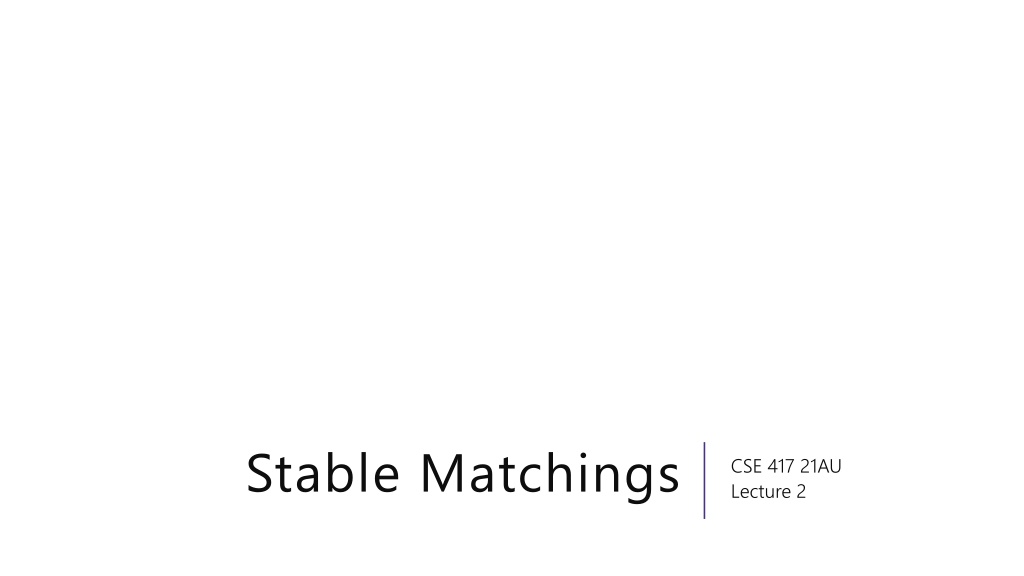
 undefined
undefined